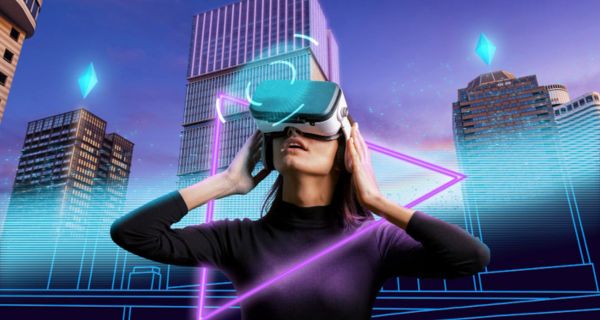Metaverse has become a buzzword among global tech enterprises and enthusiasts. The new talk of the town is built on multiple elements from existing cutting-edge technologies. It projects a resounding future for businesses and enterprises from various sectors. But in literal terms, what is the Metaverse? Nobody knows! Since the idea is an ongoing initial development phase, we thought of explaining it to you more easily and clearly.
So, what is the Metaverse per development so far?

Metaverse Definition: Developments in the Web 3.0 industry suggest Metaverse as a fully immersive and interactive virtual space where users can experience a 3D world and interact with each other in real time. The convergence of physical and virtual realities creates this virtual world. It is often described as the future of the internet, considering its impact on how we utilize and interact with its content. The idea has been around for several years, but recent technological advancements have made it a more feasible reality. This article will explore the Metaverse, how it works, and its essential work applications in the business world.
Let’s get started!
Understanding Metaverse from the Start
The idea can be traced back to the 1992 novel Snow Crash by Neal Stephenson, where he envisioned a virtual reality where people could interact with each other and live out their fantasies. This vision was later popularized in movies such as The Matrix and Ready Player One.
The idea started gaining attention in the tech industry in the early 2000s when virtual worlds like Second Life gained popularity. Second Life was one of the first virtual worlds where users could te their avatars, interact with each other in real time, and even build virtual businesses. The popularity of Second Life led to the development of other virtual worlds, such as World of Warcraft, EVE Online, and Minecraft.
Facebook & the Metaverse
In 2014, Facebook acquired the virtual reality company Oculus, which signaled its developing component of virtual reality and the Metaverse. Since then, Facebook has been working on various projects related to virtual reality, such as Oculus Quest and Horizon Workrooms.
Facebook was also accredited for The term “Metaverse,” gaining mainstream attention and awareness in October 2021 when it announced that it was rebranding its parent company as Meta. This announcement coincided with the company’s plans to invest heavily in virtual and augmented reality and the development of the Metaverse.
The current state of the Metaverse and the companies driving its development
Metaverse registered immense growth and picked up pace globally in 2021 when Facebook CEO Mark Zuckerberg put forward his thoughts on it and how it will be the next big thing with the internet revolution in place. Meta spent billions in Metaverse development and acquired VR headsets development company Oculus with a vision of becoming a leader in the space by controlling Metaverse’s hardware and software aspects. Sounds fabulous, right? But here’s the catch. Artificial intelligence-based conversational artificial intelligence solutions grabbed global attention in this span, and the limelight shifted rapidly to conversational AI development. However, the credit also goes to OpenAI, which made a breakthrough with its conversational AI chatbot, ChatGPT.
Meta kept building Metaverse despite the global backlash they received on their budget for immersive experience development. Their metaverse, Horizon Worlds, failed to get traffic and attract users amid the confusion regarding Metaverse for the common man.
Tim Cook, the CEO of the tech giant Apple, also commented on Meta’s failure to make it big. He expressed his doubts about the possibilities of Metaverse becoming mainstream since it was not easy for an average person to understand how it would positively impact their life.
Finally, Meta has decided to move on and indulge in Conversational AI algorithm developments to create a separate revenue stream and fulfill their plan for the efficient year 2023. The news came after the tech giant laid off more than 10000 employees to cut costs amid rising inflation in the West and created a huge impact on the future of the workforce developing metaverse for Meta.
However, Metaverse technology is picking up among businesses globally. Many small to medium-scale enterprises got into Metaverse as software development for businesses and enterprises who could utilize it for a better customer experience and immersive realities. One example is Yuga Labs, which created a one-stop platform for artists, gamers, and community builders to interact, communicate and entertain in Metaverse. Industry leaders and experts still expect it to grow at a massive compound annual growth rate of 39.8 percent, as per a report published in the Economic Times that projects a huge valuation of 996 billion dollars by 2030. One big reason for these projections is the immense capability of the Metaverse to transform how people shop, work, consume content, communicate and interact.
Elements that make up the Metaverse of today – Virtual worlds, Avatars, & Virtual economies
Talking about the structural assessment of the Metaverse, there are some crucial elements, including virtual worlds, virtual avatars, and their role in building a virtual ecosystem for global economic development and growth. The potential is broader than you can think of.
Virtual avatars are the basic component of a metaverse allowing users to perform actions and activities. The concept of virtual avatars is crucial, considering that there is a huge bandwidth of virtual avatar development and their customization to ensure people can change how others see them better, eliminating the limitations and setbacks associated with virtual avatar development.
Regarding virtual worlds, the metaverse can be built into anything, from a space-like environment to gaming zones, supermarkets, malls, and schools. The vision of transforming a user’s everyday experience with immersive add-ons and 3D rendering makes Metaverse stand out more than other developments happening in the industry at a great pace.
Apart from it, you might be wondering how it helps strengthen the virtual economy. That’s because of other key Web3 products that can be embedded with Metaverse, like NFTs which greatly impact how businesses and individuals utilize the internet regarding data and financial transactions. The bigger picture is yet to come, but the results are promising to a great extent.
Also, the developments have been made possible by advancements in several related technologies, including virtual reality, augmented reality, blockchain, and artificial intelligence. These technologies have enabled the creation of fully immersive and interactive virtual environments capable of supporting real-time user interactions.
Privacy concerns and the possibility of creating new forms of inequality

Facebook destabilized industries and organizations and stood up for Metaverse as a potential technological breakthrough that could revolutionize how enterprises, businesses, and the internet would look. And it is significantly important to understand that Facebook (now Meta) has been constantly in the news for its user data privacy and concerns. Their business model is built on acquiring user data and using this data for advertising and behavioral targeting, not to forget collecting personal information about their user.
Metaverse, built with technologies like augmented and virtual realities, machine learning algorithms, and artificial intelligence, generates and collects a lot of user data and preferences to offer a more personalized and customized experience that brings more light to these data and associated privacy concerns. Facebook has launched its gaming metaverse for the public. Still, no specific cybersecurity policy or strategy could tackle these challenges.
NordVpn organized a survey highlighting user concerns regarding Metaverse’s privacy and data security issues. The survey showed that 50% of users were worried about their identity management in Metaverse and feared their identities being publicly revealed on the internet, irrespective of it being a decentralized ecosystem. Also, almost 47% and 45% of users were worried about forced data surveillance and abuse of personal information, respectively.
To sum up, these concerns are not just potential concerns; they can be very real, especially when dealing with companies like Meta ( formerly Facebook), which have a bad reputation in personal data management and security.
To be specific about these potential concerns, here is an overlay of some of Metaverse’s most crucial data and security issues.
Phishing Attacks
Metaverse can be a hub for phishing as a service cyberattack. These attacks can be designed and molded to steal user information in a particular manner that the decentralized ecosystem cannot track.
Device Tracking
AR/VR devices are new to the industry and lack data security measures. These devices can be a hub for data breaches and malware invasions.
Lack of Legal Tenders
Metaverse is in its initial stages of development and does not have dedicated legal documentation to protect user data and identity. It took almost 50+ years to build this legal documentation and laws for a secure internet. Wondering if we could do this earlier after seeing the potential threats without proper legal documentation to protect user identity.
Personal Data Collection
If you have played the game ‘Second Life,’ you might be familiar with collecting user data in unauthorized ways by using virtual avatars. Experts also believe that Metaverse can potentially analyze and collect huge amounts of personal information like biometric data, preferences, health information, and brainwaves.
How can these Data Security Concerns be addressed?
Whatever the privacy concerns are, there are multiple ways to address these issues and drive effective security and personal data management solutions. Businesses and enterprises planning to establish their offices in Metaverse should work on developing their security and data privacy concerns to regulate the use of personal information and give the user more control over how their generated data will be used. Another prominent front is AR/VR Platforms and devices which lack dedicated cybersecurity development to ensure a secure operation. There should be legal documentation to eliminate the risk of privacy invasions and data breaches for individuals and businesses.
What could the Metaverse look like, and how could it evolve?
You might have heard about the diverse possibilities of use cases possible with Metaverse in gaming, education, and e-commerce, and the list is never-ending. Gaming in Metaverse uses intense hardware like haptic feedback sensors to get a real feel of the in-game action. Apart from that, many companies focus on innovating small-small parts of a fully developed metaverse ecosystem. For instance, CES gadgets are building a system that allows users to smell in a Metaverse. The development is still in the initial phase and limits the smell accessibility to Roses, but the potential is endless.
Similarly, OVR Technology is building a VR accessory that allows users to smell smoke and toast marshmallows. Industry leaders and experts believe that the smell and limbic system is an essential part of the metaverse as it directly affects the crucial functioning of emotion and memory.
Meta’s failure is remarkable, but one cannot explicitly ignore the success of these SMEs in Metaverse. SocialDream, a French startup, has designed its Mixed Reality (MR) headsets to create memory simulations for Alzheimer’s patients. Remarkable, isn’t it?
Moving forward, we need to change our approach toward the Metaverse and start seeing it as a new opportunity to discover new use cases that are not limited by the boundaries of the real world. For example, Red 6, a company, uses Metaverse to train jet fighters and prepare them for combat situations without letting them go out at risk, thus saving massive money and human life. Similarly, NASA has partnered with Epic Games to train astronauts for their Mission to Mars in 2030. They will use the Metaverse to create virtual environments replicating Mars and help astronauts train by completing tasks with the help of immersive realities. Talking about Meta, they have also changed their approach to gain traction with Horizon Worlds. They have extended their offerings to more young players by lowering the minimum age requirement to access their Metaverse.
While it is unclear what a fully developed Metaverse ecosystem will look like, the growth in the domain has been promising, with numerous Metaverses currently functioning in various sectors. Despite Meta’s initial failure to gain traction, the Metaverse has become popular among businesses globally, with many small to medium-scale enterprises utilizing it for a better customer experience and immersive realities. So, if you are ready to upgrade to the Metaverse and stay ahead of the competition, create your own Metaverse space with PlugXR’s intuitive platform, using drag-and-drop. Experts predict that the Metaverse will grow at a massive compound annual growth rate of 39.8% and have a huge valuation of 996 billion dollars by 2030.

